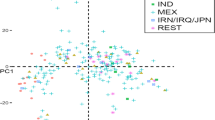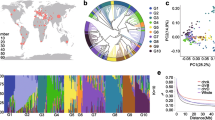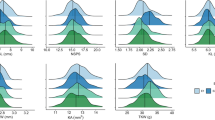Abstract
Kernel number per spike (KNPS) is one of the key factors affecting wheat yield, which can be significantly reduced by lower fertility or sterility of the apical and basal spikelets. In this study, the spikelet number per spike (SNPS), thousand kernel weight (TKW), KNPS, total grain numbers of the top three apical spikelets (GNAS), and total grain numbers of the bottom three basal spikelets (GNBS) of 212 wheat lines were recorded from five different environmental conditions. These 212 accessions were genotyped using the 9K iSelect SNP Beadchip. A total of 3269 SNP markers were used for genome-wide association analysis (GWAS). One hundred twelve significant marker-trait associations (MTAs) were identified. Twenty-two MTAs were identified in at least two environments and two of them showed association with two or more grain setting properties. Different loci showed an additive effect with both GNAS and GNBS being much higher in the lines with more favorite alleles. Two SNP loci, wsnp_Ex_c31799_40545376 and wsnp_BF293620A_Ta_2_3, showed the largest effects on increasing KNPS through improved fertility of apical and basal spikelets, respectively. These MTAs have the potential to be used in future marker-assisted selection.




Similar content being viewed by others
References
Acreche MM, Briceño-Félix G, Sánchez JAM, Slafer GA (2008) Physiological bases of genetic gains in Mediterranean bread wheat yield in Spain. Eur J Agron 28:162–170
Ain Q, Rasheed A, Anwar A, Mahmood T, Imtiaz M, Mahmood T, Xia X, He Z (2015) Genome-wide association for grain yield under rainfed conditions in historical wheat cultivars from Pakistan. Front Plant Sci 6:743
Akter MB, Piao R, Kim B, Lee Y, Koh E, Koh HJ (2014) Fine mapping and candidate gene analysis of a new mutant gene for panicle apical abortion in rice. Euphytica 197:387–398
Arisnabarreta S, Miralles DJ (2006) Floret development and grain setting in near isogenic two- and six-rowed barley lines (Hordeum vulgare L.). Field Crop Res 96:466–476
Bancal P (2009) Early development and enlargement of wheat floret primordia suggest a role of partitioning within spike to grain set. Field Crop Res 110:44–53
Bernardo R (1996a) Test cross additive and dominance effects in best linear unbiased prediction of maize single-cross performance. Theor Appl Genet 93:1098–1102
Bernardo R (1996b) Best linear unbiased prediction of maize single-cross performance. Crop Sci 36:50–56
Bernardo R, Murigneux A, Karaman Z (1996) Marker-based estimates of identity by descent and alikeness in state among maize inbreds. Theor Appl Genet 93:262–267
Bradbury PJ, Zhang ZW, Kroon DE, Casstevens TM, Ramdoss Y, Buckler ES (2007) TASSEL: software for association mapping of complex traits in diverse samples. Bioinformatics 23:2633–2635
Cavanagh CR, Chao S, Wang S, Huang BE, Stephen S, Kiani S, Forrest K, Saintenac C, Brown-Guedira GL, Akhunova A, See D, Bai G, Pumphrey M, Tomar L, Wong D, Kong S, Reynolds M, da Silva ML, Bockelman H, Talbert L, Anderson JA, Dreisigacker S, Baenziger S, Carter A, Korzun V, Morrell PL, Dubcovsky J, Morell MK, Sorrells ME, Hayden MJ, Akhunov E (2013) Genome-wide comparative diversity uncovers multiple targets of selection for improvement in hexaploid wheat landraces and cultivars. Proc Natl Acad Sci U S A 110:8057–8062
Cheng ZJ, Mao BG, Gao SW, Zhang L, Wang JL, Lei CL, Zhang X, Wu FQ, Guo XP, Wan J (2011) Fine mapping of qPAA8, a gene controlling panicle apical development in rice. J Integr Plant Biol 53:710–718
Dencic S, Kastori R, Kobiljski B, Duggan B (2000) Evaluation of grain yield and its components in wheat cultivars and landraces under near optimal and drought conditions. Euphytica 113:43–52
Dreccer MF, Wockner KB, Palta JA, McIntyre CL, Borgognone MG, Bourgault M, Reynolds M, Miralles DJ (2014) More fertile florets and grains per spike can be achieved at higher temperature in wheat lines with high spike biomass and sugar content at booting. Funct Plant Biol 41:482
Evanno G, Regnaut S, Goudet J (2005) Detecting the number of clusters of individuals using the software STRUCTURE: a simulation study. Mol Ecol 14:2611–2620
Ferrante A, Savin R, Slafer GA (2010) Floret development of durum wheat in response to nitrogen availability. J Exp Bot 61:4351–4359
Ferrante A, Savin R, Slafer GA (2012) Differences in yield physiology between modern, well adapted durum wheat, cultivars grown under contrasting conditions. Field Crop Res 136:52–64
Ferrante A, Savin R, Slafer GA (2013a) Floret development and grain setting differences between modern durum wheats under contrasting nitrogen availability. J Exp Bot 64:169–184
Ferrante A, Savin R, Slafer GA (2013b) Is floret primordia death triggered by floret development in durum wheat? J Exp Bot 64:2859–2869
Fischer RA (2008) The importance of grain or kernel number in wheat: a reply to Sinclair and Jamieson. Field Crop Res 105:15–21
Gallavotti A, Malcomber S, Gaines C, Stanfield S, Whipple C, Kellogg E, Schmidt RJ (2011) BARREN STALK FASTIGIATE1 is an AT-hook protein required for the formation of maize ears. Plant Cell 23:1756–1771
Gao FM, Wen WE, Liu JD, Rasheed A, Yin GH, Xia XC, Wu XX, He ZH (2015) Genome-wide linkage mapping of QTL for yield components, plant height and yield-related physiological traits in the Chinese wheat cross Zhou 8425B/Chinese spring. Front Plant Sci 6:1099
Gao FM, Ma DY, Yin GH, Rasheed A, Dong Y, Xiao YG, Xia XC, Wu XX, He ZH (2017) Genetic progress in grain yield and physiological traits in Chinese wheat cultivars of Southern Yellow and Huai valley since 1950. Crop Sci 57:760–773
González FG, Miralles DJ, Slafer GA (2011) Wheat floret survival as related to pre-anthesis spike growth. J Exp Bot 62:4889–4901
González-Navarro OE, Griffiths S, Molero G, Reynolds MP, Slafer GA (2015) Dynamics of floret development determining differences in spike fertility in an elite population of wheat. Field Crop Res 172:21–31
Guo Z, Schnurbusch T (2015) Variation of floret fertility in hexaploid wheat revealed by tiller removal. J Exp Bot 66:5945–5958
Guo J, Zhang Y, Shi WP, Zhang BQ, Zhang JJ, Xu YH, Cheng XM, Cheng K, Zhang XY, Hao CY, Cheng SH (2015) Front Plant Sci 6:1029. Association analysis of grain-setting rate at the apical and basal spikelets in bread wheat (Triticum aestivum L
Guo Z, Chen D, Alqudah AM, Röder MS, Ganal MW, Schnurbusch T (2017) Genome-wide association analyses of 54 traits identified multiple loci for the determination of floret fertility in wheat. New Phytol 214:257–270
Hawkesford MJ, Araus JL, Park R, Calderini D, Miralles D, Shen T, Zhang J, Parry MAJ (2013) Prospects of doubling global wheat yields. Food Energy Secur 2:34–48
Langer RHM, Hanif M (1973) A study of floret development in wheat (Triticum aestivum L.). Ann Bot 37:743–751
Li SB, Qian Q, Fu ZM, Zeng DL, Meng XB, Kyozuka J, Maekawa M, Zhu XD, Zhang J, Li JY, Wang YH (2009) Short panicle1 encodes a putative PTR family transporter and determines rice panicle size. Plant J 58:592–605
Liu KJ, Muse SV (2005) PowerMarker: an integrated analysis environment for genetic marker analysis. Bioinformatics 21:2128–2129
Meng ZD, Zhang FJ, Ding ZH, Sun Q, Wang LM, Guo QF, Wang HG (2007) Inheritance of ear tip-barrenness trait in maize. Agric Sci China 6:628–633
Milner SG, Maccaferri M, Huang BE, Mantovani P, Massi A, Frascaroli E, Tuberosa R, Salvi S (2016) A multiparental cross population for mapping QTL for agronomic traits in durum wheat (Triticum turgidum ssp. durum). Plant Biotechnol J 14:735–748
Mirabella NE, Abbate PE, Ramirez IA, Pontaroli AC (2015) Genetic variation for wheat spike fertility in cultivars and early breeding materials. J Agric Sci 154:13–22
Mishra SP, Mohapatra PK (1987) Soluble carbohydrates and floret fertility in wheat in relation to population density stress. Ann Bot 60:269–277
Piao S, Ciais P, Huang Y, Shen Z, Peng S, Li J, Zhou L, Liu H, Ma Y, Ding Y, Friedlingstein P, Liu C, Tan K, Yu Y, Zhang T, Fang J (2010) The impacts of climate change on water resources and agriculture in China. Nature 467:43–51
Pritchard JK, Stephens M, Rosenberg NA, Donnelly P (2000) Association mapping in structured populations. Am J Hum Genet 67:170–181
Rerkasem B, Jamjod S (1997) Boron deficiency induced male sterility in wheat (Triticum aestivum L.) and implications for plant breeding. Euphytica 96:257–262
Reynolds M, Foulkes MJ, Slafer GA, Berry P, Parry MA, Snape JW, Angus WJ (2009) Raising yield potential in wheat. J Exp Bot 60:1899–1918
Saifuzzaman M, Fattah QA, Islam MS (2008) Spikelet sterility of wheat in farmer’s field in Northwest Bangladesh. Bangladesh J Bot 37:155–160
Satoh-Nagasawa N, Nagasawa N, Malcomber S, Sakai H, Jackson D (2006) A trehalose metabolic enzyme controls inflorescence architecture in maize. Nature 441:227–230
Sharp PJ, Chao S, Desai S, Gale MD (1989) The isolation, characterization and application in the Triticeae of a set of wheat RFLP probes identifying each homoeologous chromosome arm. Theor Appl Genet 78:342–348
Shitsukawa N, Kinjo H, Takumi S, Murai K (2009) Heterochronic development of the floret meristem determines grain number per spikelet in diploid, tetraploid and hexaploid wheats. Ann Bot 104:243–251
Sun C, Zhang F, Yan X, Zhang X, Dong Z, Cui D, Chen F (2017) Genome-wide association study for 13 agronomic traits reveals distribution of superior alleles in bread wheat from the Yellow and Huai Valley of China. Plant Biotechnol J 15:953–969
Tan CJ, Sun YJ, Xu HS, Yu SB (2011) Identification of quantitative trait locus and epistatic interaction for degenerated spikelets on the top of panicle in rice. Plant Breed 130:177–184
Tripathi A, Tripathi DK, Chauhan DK, Kumar N, Singh GS (2016) Paradigms of climate change impacts on some major food sources of the world: a review on current knowledge and future prospects. Agric Ecosyst Environ 216:356–373
Wang SC, Wong D, Forrest K, Allen A, Chao S, Huang BE, Maccaferri M, Salvi S, Milner SG, Cattivelli L, Mastrangelo AM, Whan A, Stephen S, Barker G, Wieseke R, Plieske J, International Wheat Genome Sequencing Consortium, Lillemo M, Mather D, Appels R, Dolferus R, Brown-Guedira G, Korol A, Akhunova AR, Feuillet C, Salse J, Morgante M, Pozniak C, Luo MC, Dvorak J, Morell M, Dubcovsky J, Ganal M, Tuberosa R, Lawley C, Mikoulitch I, Cavanagh C, Edwards KJ, Hayden M, Akhunov E (2014) Characterization of polyploid wheat genomic diversity using a high-density 90000 single nucleotide polymorphism array. Plant Biotechnol J 12:787–796
Yamagishi J, Miyamoto N, Hirotsu S, Laza RC, Nemoto K (2004) QTLs for branching, floret formation, and pre-flowering floret abortion of rice panicles in a temperate japonica × tropical japonica cross. Theor Appl Genet 109:1555–1561
Yu JM, Pressoir G, Briggs WH, Bi IV, Yamasaki M, Doebley JF, McMullen MD, Gaut BS, Nielsen DM, Holland JB, Kresovich S, Buckler ES (2005) A unified mixed-model method for association mapping that accounts for multiple levels of relatedness. Nat Genet 38:203–208
Zhang ZW, Ersoz E, Lai CQ, Todhunter RJ, Tiwari HK, Gore MA, Bradbury PJ, Yu J, Arnett DK, Ordovas JM, Buckler ES (2010) Mixed linear model approach adapted for genome-wide association studies. Nat Genet 42:355–360
Zheng C, Zhu Y, Zhu HJ, Kang G, Guo T, Wang C (2014) Floret development and grain setting characteristics in winter wheat in response to pre-anthesis foliar applications of 6-benzylaminopurine and boron. Field Crop Res 169:70–76
Zheng C, Zhu Y, Wang C, Guo T (2016) Wheat grain yield increase in response to pre-anthesis foliar application of 6-benzylaminopurine is dependent on floret development. PLoS One 11:e0156627
Zheng Z, Gao S, Zhou MX, Yan GJ, Liu CJ (2017) Enhancing Fusarium crown rot resistance by pyramiding large-effect QTL in common wheat (Triticum aestivum L.). Mol Breed 37:107
Zhou MX (2011) Accurate phenotyping reveals better QTL for waterlogging tolerance in barley. Plant Breed 130:203–208
Funding
This work was supported by grants from the National Key R&D Program of China (2017YFD0101000), the National Key R&D Program of Shanxi Province (201703D211007), the Technology Innovation Program of Higher Education of Shanxi Province (2017142), and the Science & Technology Innovation Foundation of Shanxi Agricultural University (2016YJ05).
Author information
Authors and Affiliations
Corresponding authors
Electronic supplementary material
Table S1
Details for 212 wheat accessions included in the germplasm set used in this study. (XLSX 18 kb)
Table S2
Allele number, MAF and PIC of 3778 polymorphic SNP markers detected in the association panel. (XLSX 301 kb)
Table S3
One hundred and twelve significant MTAs involving 88 SNP loci and eleven phenotypic traits. (XLSX 36 kb)
Table S4
Best blast hit of wheat SNP flanking sequence/Genebank against genomic sequence (IWGSC) of Triticum aestivum. (XLSX 10 kb)
Fig. S1
Population structure of 212 cultivars based on 3778 unlinked SNP markers. a: Plot of ΔK against putative K ranging from 1 to 12; b: Stacked bar plot of ancestry relationships of 212 wheat cultivars. (PNG 96 kb)
Fig. S2
The information of overlapping genes ranged from 585.0 Mb to 589.5 Mb on chromosome 5A. (PNG 311 kb)
Rights and permissions
About this article
Cite this article
Shi, W., Yue, L., Cheng, J. et al. A genome-wide associate study reveals favorable alleles conferring apical and basal spikelet fertility in wheat (Triticum aestivum L.). Mol Breeding 38, 146 (2018). https://doi.org/10.1007/s11032-018-0906-y
Received:
Accepted:
Published:
DOI: https://doi.org/10.1007/s11032-018-0906-y




